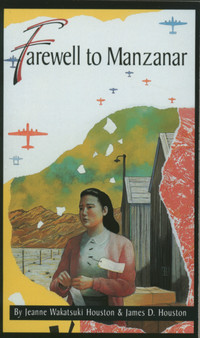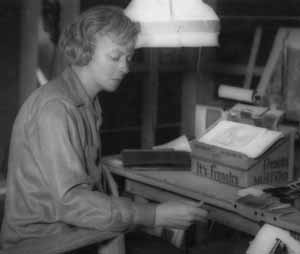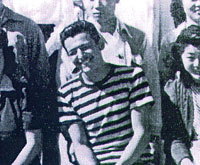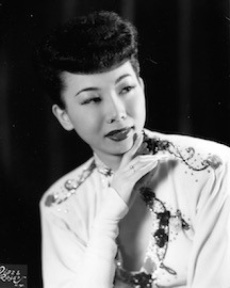Related Research Articles

Manzanar is the site of one of ten American concentration camps, where more than 120,000 Japanese Americans were incarcerated during World War II from March 1942 to November 1945. Although it had over 10,000 inmates at its peak, it was one of the smaller internment camps. It is located at the foot of the Sierra Nevada mountains in California's Owens Valley, between the towns of Lone Pine to the south and Independence to the north, approximately 230 miles (370 km) north of Los Angeles. Manzanar means "apple orchard" in Spanish. The Manzanar National Historic Site, which preserves and interprets the legacy of Japanese American incarceration in the United States, was identified by the United States National Park Service as the best-preserved of the ten former camp sites.

During World War II, the United States forcibly relocated and incarcerated about 120,000 people of Japanese descent in ten concentration camps operated by the War Relocation Authority (WRA), mostly in the western interior of the country. Approximately two-thirds of the detainees were United States citizens. These actions were initiated by Executive Order 9066, issued by President Franklin D. Roosevelt on February 19, 1942, following Imperial Japan's attack on Pearl Harbor, Guam, the Philippines, and Wake Island in December 1941. Before the war, about 127,000 Japanese Americans lived in the continental United States, of which about 112,000 lived on the West Coast. About 80,000 were Nisei and Sansei. The rest were Issei immigrants born in Japan, who were ineligible for citizenship. In Hawaii, where more than 150,000 Japanese Americans comprised more than one-third of the territory's population, only 1,200 to 1,800 were incarcerated.

The War Relocation Authority (WRA) was a United States government agency established to handle the internment of Japanese Americans during World War II. It also operated the Fort Ontario Emergency Refugee Shelter in Oswego, New York, which was the only refugee camp set up in the United States for refugees from Europe. The agency was created by Executive Order 9102 on March 18, 1942, by President Franklin D. Roosevelt, and was terminated June 26, 1946, by order of President Harry S. Truman.

Farewell to Manzanar is a memoir published in 1973 by Jeanne Wakatsuki Houston and James D. Houston. The book describes the experiences of Jeanne Wakatsuki and her family before, during, and following their relocation to the Manzanar internment camp due to the United States government's internment of Japanese Americans during World War II. It was adapted into a made-for-TV movie in 1976 starring Yuki Shimoda, Nobu McCarthy, James Saito, Pat Morita, and Mako.

The Heart Mountain War Relocation Center, named after nearby Heart Mountain and located midway between the northwest Wyoming towns of Cody and Powell, was one of ten concentration camps used for the internment of Japanese Americans evicted during World War II from their local communities in the West Coast Exclusion Zone by the executive order of President Franklin Roosevelt.

The Gila River War Relocation Center was an American concentration camp in Arizona, one of several built by the War Relocation Authority (WRA) during the Second World War for the incarceration of Japanese Americans from the West Coast. It was located within the Gila River Indian Reservation near the town of Sacaton, about 30 mi (48.3 km) southeast of Phoenix. With a peak population of 13,348, it became the fourth-largest city in the state, operating from May 1942 to November 16, 1945.

Minidoka National Historic Site is a National Historic Site in the western United States. It commemorates the more than 13,000 Japanese Americans who were imprisoned at the Minidoka War Relocation Center during the Second World War. Among the inmates, the notation 峰土香 or 峯土香 was sometimes applied.

The Topaz War Relocation Center, also known as the Central Utah Relocation Center (Topaz) and briefly as the Abraham Relocation Center, was an American concentration camp in which Americans of Japanese descent and immigrants who had come to the United States from Japan, called Nikkei were incarcerated. President Franklin Roosevelt signed Executive Order 9066 in February 1942, ordering people of Japanese ancestry to be incarcerated in what were euphemistically called "relocation centers" like Topaz during World War II. Most of the people incarcerated at Topaz came from the Tanforan Assembly Center and previously lived in the San Francisco Bay Area. The camp was opened in September 1942 and closed in October 1945.

The Jerome War Relocation Center was a Japanese American internment camp located in southeastern Arkansas, near the town of Jerome in the Arkansas Delta. Open from October 6, 1942, until June 30, 1944, it was the last American concentration camp to open and the first to close. At one point it held as many as 8,497 detainees. After closing, it was converted into a holding camp for German prisoners of war. Today, few remains of the camp are visible, as the wooden buildings were taken down. The smokestack from the hospital incinerator still stands.

The Rohwer War Relocation Center was a World War II Japanese American concentration camp located in rural southeastern Arkansas, in Desha County. It was in operation from September 18, 1942, until November 30, 1945, and held as many as 8,475 Japanese Americans forcibly evacuated from California. Among the inmates, the notation "朗和" was sometimes applied. The Rohwer War Relocation Center Cemetery is located here, and was declared a National Historic Landmark in 1992.
On February 19, 1942, shortly after Japan's surprise attack on Pearl Harbor in Hawaii, President Franklin D. Roosevelt signed Executive Order 9066 authorizing the forced removal of over 110,000 Japanese Americans from the West Coast and into internment camps for the duration of the war. The personal rights, liberties, and freedoms of Japanese Americans were suspended by the United States government. In the "relocation centers", internees were housed in tar-papered army-style barracks. Some individuals who protested their treatment were sent to a special camp at Tule Lake, California.
The following article focuses on the movement to obtain redress for the internment of Japanese Americans during World War II, and significant court cases that have shaped civil and human rights for Japanese Americans and other minorities. These cases have been the cause and/or catalyst to many changes in United States law. But mainly, they have resulted in adjusting the perception of Asian immigrants in the eyes of the American government.
Robert Akira Nakamura is a filmmaker and teacher, sometimes referred to as "the Godfather of Asian American media." In 1970 he cofounded Visual Communications (VC) the oldest community-based Asian Pacific American media arts organization in the United States.
Togo "Walter" Tanaka was an American newspaper journalist and editor who reported on the difficult conditions in the Manzanar camp, where he was one of 110,000 Japanese Americans who had been relocated after the Japanese attack on Pearl Harbor on December 7, 1941.

The Manzanar Children's Village was an orphanage for children of Japanese ancestry incarcerated during World War II as a result of Executive Order 9066, under which President Franklin D. Roosevelt authorized the forced removal of Japanese Americans from the West Coast of the United States. Contained within the Manzanar concentration camp in Owens Valley, California, it held a total of 101 orphans from June 1942 to September 1945.

Estelle Ishigo, née Peck, was an American artist known for her watercolors, pencil and charcoal drawings, and sketches. During World War II she and her husband were incarcerated at the Heart Mountain Relocation Center in Wyoming. She subsequently wrote about her experiences in Lone Heart Mountain and was the subject of the Oscar winning documentary Days of Waiting: The Life & Art of Estelle Ishigo.

Ralph Lazo was the only known non-spouse, non-Japanese American who voluntarily relocated to a Japanese American internment camp during World War II. His experience was the subject of the 2004 narrative short film Stand Up for Justice: The Ralph Lazo Story.
Mary Kageyama Nomura is an American singer of Japanese descent who was relocated and incarcerated for her ancestry at the Manzanar concentration camp during World War II and became known as The songbird of Manzanar.

Mary Mon Toy was a Japanese American actress, showgirl, and secretary. She is best known for her role in the Broadway production of The World of Suzie Wong as Minnie Ho.
References
- ↑ Day of Independence official website
- ↑ Brian Niiya, "If Tomorrow Comes" Densho Encyclopedia
- ↑ Niiya, Brian. "442: For the Future (film)". Densho. Retrieved March 21, 2018.
- ↑ "Movie Review: 442-LIVE WITH HONOR; DIE WITH DIGNITY". Hawaii News Now. Retrieved 2018-01-17.
- ↑ Adams, Mark (November 3, 2010). "442 – Live With Honor, Die With Dignity". Screen Daily. Retrieved 2018-01-17.
- ↑ Gerster, Carole; Zlogar, Laura W. (2006-01-02). Teaching Ethnic Diversity with Film: Essays and Resources for Educators in History, Social Studies, Literature and Film Studies. McFarland. p. 122. ISBN 9780786421954.
- ↑ "All We Could Carry". FARALLON FILMS. Archived from the original on February 23, 2017. Retrieved 2018-03-22.
- ↑ Niiya, Brian. "America at its Best: Legacy of Two Nisei Patriots (film)". Densho. Retrieved March 21, 2018.
- ↑ "And Then They Came for Us". 2019. Retrieved 2020-11-14.
- ↑ "The Art of Gaman: Arts and Crafts from the Japanese American Internment Camps, 1942-1946 (exhibition) | Densho Encyclopedia". encyclopedia.densho.org. Retrieved 2018-03-22.
- ↑ McCarthy, Todd (1997-07-20). "Beyond Barbed Wire". Variety. Retrieved 2018-03-22.
- ↑ "Camp Amache: The Story of an American Tragedy with producer/authors Don & Sandy Dexter | Pueblo City-County Library District". www.pueblolibrary.org. Archived from the original on October 9, 2012. Retrieved 2018-03-22.
- ↑ "Caught in Between: What to Call Home in Times of War | UC Berkeley Library". www.lib.berkeley.edu. Archived from the original on February 11, 2018. Retrieved 2018-03-22.
- ↑ "ALTERNATIVE FACTS: The Lies of Executive Order 9066". New Day Films. 2019-11-10. Retrieved 2021-01-07.
- ↑ "Home". ALTERNATIVEFACTS9066. Retrieved 2021-01-07.
- ↑ "Children of the Camps: the Japanese American WWII internment camp experience". www.pbs.org. Archived from the original on December 3, 2017. Retrieved 2018-03-22.
- ↑ Horsting, Robert. "Citizen Tanouye". www.citizentanouye.com. Archived from the original on September 29, 2017. Retrieved 2018-03-22.
- ↑ "The Color of Honor - Japanese Americans and World War II internment film". www.cetel.org. Archived from the original on January 12, 2017. Retrieved 2018-03-22.
- ↑ "Conscience And The Constitution (DVD)". Japanese American National Museum Store. Archived from the original on September 23, 2015. Retrieved 2018-03-22.
- ↑ "1a". pages.gseis.ucla.edu. Retrieved 2018-03-22.
- ↑ Niiya, Brian. "Democracy Under Pressure: Japanese Americans and World War II (film)". Densho.
- ↑ "Film Screening of "A Divided Community" & Discussion with Filmmaker Momo Yashima". Interdisciplinary Center for the Study of Global Change. 2016-02-12. Archived from the original on February 28, 2018. Retrieved 2018-03-22.
- ↑ Ling, Huping (2015-03-17). Asian American history and culture : an encyclopedia. Austin, Allan W. ([Enhanced Credo edition] ed.). Armonk, New York: Routledge. p. 45. ISBN 978-1317476450. OCLC 889717915.
- ↑ Shindo, Tak (1980), Encounter with the past: American-Japanese internment in World War II, Eurasia Publications, OCLC 8741684
- ↑ Aderer, Konrad; Abdel-Muhti, Farouk; Darmi, Peter; Third World Newsreel (Firm) (2011), Enemy alien, OCLC 753869306
- ↑ "A Flicker in Eternity--Stanley Hayami (DVD)". Japanese American National Museum Store. Archived from the original on April 1, 2016. Retrieved 2018-03-22.
- ↑ Hosley, David H; Mastrandrea, James; Gravitt, Corita; Johnson, Mark; Yanehiro, Jan; Osaki, Paul; Honnami, Sumi; Maeda, Wayne; Komai, Chris (2003), Forced out: [internment and the enduring damage to California's cities and towns, KVIE, OCLC 61671981
- ↑ "Forsaken Fields – CAAM Home". caamedia.org. Archived from the original on April 15, 2016. Retrieved 2018-03-22.
- ↑ "From a Silk Cocoon - A Japanese American Renunciation Story". www.fromasilkcocoon.com. Archived from the original on September 15, 2017. Retrieved 2018-03-22.
- ↑ Wakida, Patricia. "Fumiko Hayashida: The Woman Behind the Symbol (film)". Densho.
- ↑ "Furusato: The Lost Village of Terminal Island (DVD)". Japanese American National Museum Store. Archived from the original on August 15, 2016. Retrieved 2018-03-22.
- ↑ Niiya, Brian. "Gila River and Mama: The Ruth Mix Story (film)". Densho.
- ↑ National Broadcasting Company (1972), Guilty by reason of race. , retrieved 2018-03-22
- ↑ "Heart Mountain: Three Years In An Internment Camp – CAAM Home". caamedia.org. Archived from the original on April 15, 2016. Retrieved 2018-03-22.
- ↑ Wakida, Patricia. "Hidden Internment: The Art Shibayama Story (film)". Densho.
- ↑ "Idaho Public Television Presents The Idaho Homefront: Of Camps and Combat". idahoptv.org. Archived from the original on September 6, 2015. Retrieved 2018-03-22.
- ↑ "In Time of War". CAAM Home. Retrieved 2021-01-07.
- ↑ Wakida, Patricia. "Interactions (film)". Densho.
- ↑ "Media Arts | Japanese American National Museum". www.janm.org. Retrieved 2021-01-07.
- ↑ "Most Honorable Son | PBS". www.pbs.org. 6 September 2015. Retrieved 2021-01-07.
- ↑ "The Music Man of Manzanar (film) - Densho Resource Guide". resourceguide.densho.org. Retrieved 2021-01-07.
- ↑ "SHIKATA GA NAI: AN INCONVENIENT AMERICAN - YouTube". www.youtube.com. Archived from the original on 2021-12-14. Retrieved 2021-01-07.
- ↑ "Valor with Honor Website". www.valorwithhonor.com. Archived from the original on 2013-03-12. Retrieved 2021-01-07.
- ↑ "Women Make Movies Website". wmm.com. Retrieved 2022-05-08.